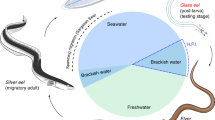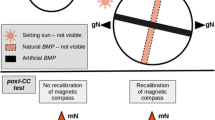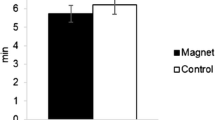Abstract
Japanese eel is already magnetosensitive at the glass eel phase. However, currently, there is no evidence that they can use geomagnetic cues for orientation. We examined orientation behaviour in a radially symmetrical test arena in which the horizontal component of the geomagnetic field could be manipulated. Groups of glass eels released at the centre of the arena showed a mean orientation angle significantly biased to the south of 198° in the ambient geomagnetic field, but showed random orientation in the geomagnetic field when its horizontal component was cancelled in a solenoid. Results showed that they use geomagnetic cues for orientation.


Similar content being viewed by others
References
Batschelet E (1981) Circular statistics in biology. Academic Press, London
Branover GG, Vasilýev AS, Gleyze SI, Tsinober AB (1971) A study of the behavior of the eel in natural and artificial and magnetic fields and an analysis of its reception mechanism. J Ichthyol [Vop Ikhtiol] 11:608–614
Dou SZ, Tsukamoto K (2003) Observations on the nocturnal activity and feeding behavior of Anguilla japonica glass eels under laboratory conditions. Environ Biol Fishes 67:389−395
Durif CMF, Browman HI, Phillips JB, Skiftesvik AB, Vøllestad LA, Stockhausen HH (2013) Magnetic compass orientation in the European eel. PLoS ONE 8:e59212
Gleyzer SI (1971) Early ontogeny of the non-conditioned reactions of eel (Anguilla anguilla) to the natural magnetic field of the earth. Trans Atl Res Inst Fish Oceanogr 36:64−71
Gleyzer SI, Khodorkovskiy VA (1971) Experimental determination of geomagnetic perception in the European eel. Rep Acad Sci USSR 201:964−967
Karlsson L (1985) Behavioural response of European silver eels (Anguilla anguilla) to the geomagnetic field. Helgoländer wiss Meeresunters 29:71−81
Kimura S, Tsukamoto K, Sugimoto T (1994) A model for the larval migration of the Japanese eel: roles of the trade winds and salinity front. Mar Biol 119:185−190
Lohmann KJ, Putman NF, Lohmann CMF (2008) Geomagnetic imprinting: A unifying hypothesis of long-distance natal homing in salmon and sea turtles. Proc Natl Acad Sci USA 105:19096–19101
McCleave JD, Power JH (1978) Influence of weak electric and magnetic fields on turning behavior in elvers of the American eel Anguilla rostrata. Mar Biol 46:29−34
Nishi T, Kawamura G (2005) Anguilla japonica is already magnetosensitive at the glass eel phase. J Fish Biol 67:1213−1224
Nishi T, Kawamura G (2006) Magnetosensitivity in the darkbanded rockfish Sebastes inermis. Nippon Suisan Gakkaishi 72:27–33
Nishi T, Kawamura G, Matsumoto K (2004) Magnetic sense in the Japanese eel, Anguilla japonica, as determined by conditioning and electrocardiography. J Exp Biol 207:2965−2970
Osipova EA, Pavlova VV, Nepomnyashchikh VA, Krylov VV (2016) Influence of magnetic field on zebrafish activity and orientation in a plus maze. Behav Process 122:80−86
Prigge E, Marohn L, Hanel R (2013) Tracking the migratory success of stocked European eels Anguilla anguilla in the Baltic Sea. J Fish Biol 82:686−699
Putman NF, Lohmann KJ, Putman EM, Klimley AP, Quinn TP, Noakes DLG (2013) Evidence for geomagnetic imprinting as a homing mechanism in Pacific salmon. Curr Biol 23:312–316
Quinn TP (1980) Evidence for celestial and magnetic compass orientation in lake-migrating sockeye salmon fry. J Comp Physiol 137:243–248
Quinn TP, Brannon EL (1982) The use of celestial and magnetic cues by orienting sockeye salmon smolts. J Comp Physiol 147:547–552
Skiles DD (1985) The geomagnetic field: its nature, history, and biological relevance. In: Kirschvink JL, Jones DS, MacFadden BJ (eds) Magnetite biomineralization and magnetoreception in organisms: a new biomagnetism. Plenum Press, New York, London, pp 43–102
Souza JJ, Poluhowich JJ, Guerra RJ (1988) Orientation responses of American eels, Anguilla rostrata, to varying magnetic fields. Comp Biochem Physiol A 90:57–61
Tesch FW (1974) Influence of geomagnetism and salinity on the directional choice of eels. Helgoländer wiss Meeresunters 26:382–395
Tesch FW, Lelek A (1973) Directional behaviour of transplanted stationary and migratory forms of the eel, Anguilla anguilla, in a circular tank. Neth J Sea Res 7:46–52
Tesch FW, Rohlf N (2003) Migration from continental waters to the spawning grounds. In: Aida K, Tsukamoto K, Yamauchi K (eds) Eel biology. Springer Tokyo, Berlin, New York, London, Paris, pp 223–234
van Ginneken V, Muusze B, Breteler JK, Jansma D, van den Thillart G (2005) Microelectronic detection of activity level and magnetic orientation of yellow European eel, Anguilla anguilla L., in a pond. Environ Biol Fishes 72(3):313–320
Zar JH (1974) Probabilities of Rayleigh’s test statistics for circular data. Behavior Research Methods 6:450–450
Zimmerman MA, McCleave JD (1975) Orientation of elvers of American eels (Anguilla rostrata) in weak magnetic and electric fields. Helgoländer wiss Meeresunters 27:175–189
Acknowledgements
The glass eels were handled according to the methods prescribed by Kagoshima University’s Guide for the Care and Use of Laboratory Animals.
Author information
Authors and Affiliations
Corresponding author
About this article
Cite this article
Nishi, T., Archdale, M.V. & Kawamura, G. Behavioural evidence for the use of geomagnetic cue in Japanese glass eel Anguilla japonica orientation. Ichthyol Res 65, 161–164 (2018). https://doi.org/10.1007/s10228-017-0587-2
Received:
Revised:
Accepted:
Published:
Issue Date:
DOI: https://doi.org/10.1007/s10228-017-0587-2




